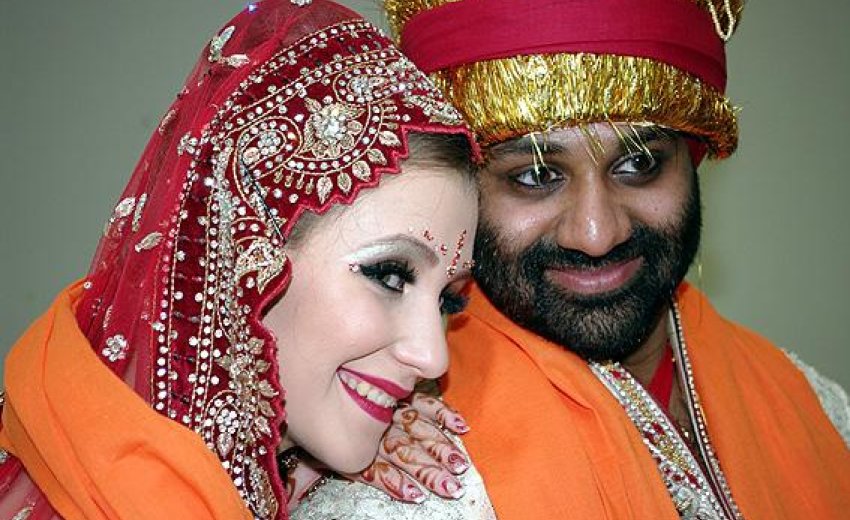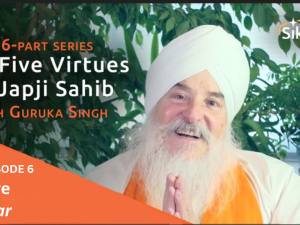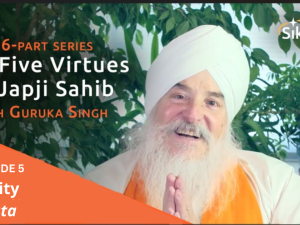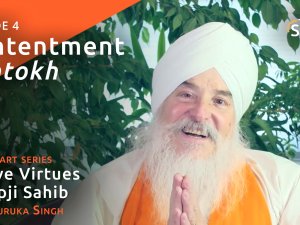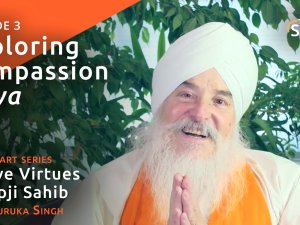Oh! what a mess it is that we sometimes make with the best of intentions and all in the name of God and love for our Gurus.
Recent incidents in Great Britain and elsewhere show us that all hell seems to be breaking out around a simple issue — and seemingly for the most sensible reasons.
A hot debate is in progress on the Internet these days, and it’s getting hotter by the day.
 What to do when a young couple, visibly infatuated
with love, wants to marry and only one of them is a Sikh but the other is
not? Should they be allowed to marry in
a gurduara and enjoy the blessings of the Guru and the sangat in congregation?
What to do when a young couple, visibly infatuated
with love, wants to marry and only one of them is a Sikh but the other is
not? Should they be allowed to marry in
a gurduara and enjoy the blessings of the Guru and the sangat in congregation?
Believe us, this is not just a tempest in a teapot, even though some would like to dismiss it as such. There are just as many or more on the other side that believe a Sikh wedding ceremony is exclusively permitted only for a couple where the bride and groom are both Sikhs. They claim that when only one, either the bride or groom is a Sikh, it becomes a hodge-podge and an anathema – an insult to centuries of hallowed Sikh tradition.
The issue is not new nor is it unique to Sikhs. It is also amenable to a little common sense, and that’s what we need. Let’s unravel the matter a bit.
It is true that communities and religions have a code of conduct that emphasizes the common values and practices of a community. This promotes and assures unity and security. Such codes define boundaries between different but neighboring communities much as good fences make good neighbors. But fences remain porous; they should never become stone walls for that would kill communication among neighbors, destroy their path to progress and undermine human societies.
All of us understand that practices like marriage and lifestyle are the fundamentals of a family. They become sacred because they guarantee continuity of a people. But the fences between neighbors do tend over time to morph into impenetrable stone walls.
For instance, not so long ago, if a mixed-faith couple wanted to marry in the Roman Catholic tradition, the non-Catholic partner was required to sign a binding agreement that all children would be raised in the Catholic faith. The past 30 odd years have seen a fair degree of rethinking and turnaround in such practices, but that’s not under the lens here today. Such restrictive binding agreements diminish the fundamentals of humanity and love in the marriage by undermining the faith of one partner or the other.
Many religions have similar laws that are binding on the believers. One must wonder about the origin of such laws. Perhaps they come from a fear of dilution of the faith, or possibly to create an insular barrier to “outsiders?” Or perhaps they are rooted in an attempt to ensure a successful marriage? If the latter, then we would say that the aim has been rather unsuccessful. We see many unhappy and broken marriages between people of the same faith, whether Sikh or not, and many successful and loving marriages between a Sikh and a “non-Sikh.”
As an example we offer Siri Narayan Kaur Khalsa and her husband, who have been happily married for 53 years. Years ago, she received Guru's Amrit and always dresses in full bana while her husband, a physicist, remains an agnostic. She says that her Lavan ceremony was deeply and profoundly meaningful, a joining of two souls into one, and that her husband has always been supportive of her daily practice and her Sikhi. And then she mused upon the question, "Was Guru Nanak's wife (Mata Sulakhani) a Sikh?"
The very foundation of our Sikh faith is openness to all. The Harimander Sahib (Golden Temple) was designed and built by our Gurus with four doors open to all four winds so that everyone is welcome.
The determination of who is and who is not a Sikh is, in fact, not up to us to decide. Who lives as a Sikh is determined, not by birth, but by the Guru. The Guru chooses his Sikh, not the other way around.
Who knows when or if Sikhi will blossom in the heart of a spouse by the Guru’s divine touch?
This is emphatically not to say that we should enter marriage blindly.
We can all understand that part of required premarital counseling for a mixed-faith couple should be a meeting with the priests (or equivalent) of both faiths for a serious conversation about the fundamentals of both faiths, so that a dose of reality gets added to the blinders of love.
If the couple can decide on the one religion that would define their new entity as a family, then it should not matter which rites they choose.
If, as some do, they want wedding rites in both faiths, one after the other, then there is an inherent problem that may surface now or years later when identity of the family and children become the issue. Because this may indicate that at some level each partner is still equally attached to his or her own tradition and that irreconcilable differences might emerge weeks, months or years later.
But there is no rhyme or reason that suggests that a faith tradition should ban mixed-faith marriages in its place of worship.
When a person enters a gurduara for a service – a keertan, for instance – no one has the right to question what kind of a Sikh or how good a Sikh he or she is. No one has the right to prevent someone, even if clearly a non-Sikh, from any of the functions in a gurduara, as long as proper respect is shown.
Even if you see mixed marriage as akin to a pothole in the road of Sikhi, it is not one that will close the road down or destroy the vehicle.
Be not afraid of non-Sikh “strangers” coming into gurduaras and participating in most seminal of our rites and practices. Welcome them!
Remember, when you first meet anyone, he or she is always a stranger. It is only time and engagement with each other that transforms a relationship into that of the best of friends and soul mates.

